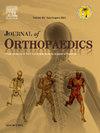全髋关节置换术后足下垂:流行病学、危险因素和相关并发症
IF 1.5
Q3 ORTHOPEDICS
引用次数: 0
摘要
背景:足下垂是全髋关节置换术后由坐骨神经和腓神经损伤引起的一种相对罕见的并发症。很少有研究评估这种具有挑战性的并发症的危险因素或发展趋势。因此,本研究旨在描述THA术后足下垂的流行病学、手术危险因素和相关并发症。方法使用PearlDiver数据库对成人原发性或改进型THA患者进行鉴定。符合条件的患者根据手术后90天内足部的发展情况被筛选到队列中,并按年龄、性别和合并症1:1匹配。在2010年至2022年期间,按年龄和年份评估了落脚的流行病学趋势。比较患者人口统计学、合并症、手术特征、医院结果以及手术中和术后并发症的发生。结果共纳入足部下垂2282例(0.3%),无足部下垂893159例(99.8%),平均年龄64.9岁,女性56.2%。从2010年到2022年,落脚率从0.3%下降到0.2%,且与年龄无关。术前,足部下降的患者更频繁地接受翻修THA(足部下降= 12.3% vs无足部下降= 5.7%,P <;0.001),并且有更多的合并症(P <;0.001)。术中出血(0.7% vs 0.2%, P = 0.034)和神经损伤(0.7% vs 0.1%, P <;0.001)。术后,他们经常报告急性肾损伤、尿路感染、伤口相关并发症、血肿、假体关节感染、无菌性松动和修复(所有P <;0.004)。结论全髋关节置换术后出现足下垂的患者多为女性,接受翻修手术,既往腰椎融合和医学合并症的发生率较高。他们报告了更多的术后并发症和THA后的后续治疗。这项研究告诉我们风险因素,可能有助于更好的患者咨询和手术计划前进行THA。本文章由计算机程序翻译,如有差异,请以英文原文为准。
Postoperative footdrop following total hip arthroplasty: Epidemiology, risk factors, and associated complications
Background
Footdrop is a relatively uncommon complication following total hip arthroplasty (THA) caused by injury to the sciatic and peroneal nerve. Few studies have evaluated the risk factors or trends for the development of this challenging complication. As such, this study aims to describe the epidemiology, procedural risk factors, and related complications of postoperative footdrop following THA.
Methods
Adult primary or revision THA patients were identified using the PearlDiver database. Eligible patients were filtered into cohorts based on the development of footdrop within 90 days of surgery and matched 1:1 by age, sex, and comorbidities. Epidemiological trends in footdrop were evaluated by age and year between 2010 and 2022. Patient demographics, comorbidities, procedural characteristics, hospital outcomes, and occurrence of intra- and post-operative complications were compared.
Results
In total, 2282 footdrop (0.3 %) and 893,159 (99.8 %) no footdrop THA patients were included, with a mean age of 64.9 years and 56.2 % were women. The incidence of footdrop decreased from 0.3 % to 0.2 % between 2010 and 2022 and was not associated with age. Preoperatively, footdrop patients more frequently underwent revision THA (Footdrop = 12.3 % vs No footdrop = 5.7 %, P < 0.001) and had more medical comorbidities (P < 0.001). Intraoperatively, they had higher rates of hemorrhage (0.7 % vs 0.2 %, P = 0.034) and nerve injury (0.7 % vs 0.1 %, P < 0.001). Postoperatively, they frequently reported acute kidney injury, urinary tract infection, wound-related complications, hematoma, prosthetic joint infection, aseptic loosening, and revisions (all P < 0.004).
Conclusion
Patients developing footdrop following THA were more likely to be women, undergoing revision surgery, and had higher rates of prior lumbar fusion and medical comorbidities. They reported more postoperative complications and subsequent revisions following THA. This study informs us of the risk factors footdrop and may contribute to better patient counseling and surgical planning before undergoing THA.
求助全文
通过发布文献求助,成功后即可免费获取论文全文。
去求助
来源期刊

Journal of orthopaedics
ORTHOPEDICS-
CiteScore
3.50
自引率
6.70%
发文量
202
审稿时长
56 days
期刊介绍:
Journal of Orthopaedics aims to be a leading journal in orthopaedics and contribute towards the improvement of quality of orthopedic health care. The journal publishes original research work and review articles related to different aspects of orthopaedics including Arthroplasty, Arthroscopy, Sports Medicine, Trauma, Spine and Spinal deformities, Pediatric orthopaedics, limb reconstruction procedures, hand surgery, and orthopaedic oncology. It also publishes articles on continuing education, health-related information, case reports and letters to the editor. It is requested to note that the journal has an international readership and all submissions should be aimed at specifying something about the setting in which the work was conducted. Authors must also provide any specific reasons for the research and also provide an elaborate description of the results.
 求助内容:
求助内容: 应助结果提醒方式:
应助结果提醒方式:


